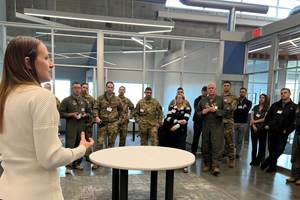US Army Tests Additive Manufacturing for Printing Vehicle Repair Parts in the Field
Spee3D participates in successful demonstration with the Army Research Lab to validate the use of additive manufacturing for creating military vehicle repair parts in the field at the point of need.
Share
Read Next
Spee3D successfully demonstrated the use of additive manufacturing for creating military vehicle repair parts in the field at the point of need. Source: Spee3D
Metal additive manufacturing provider Spee3D has demonstrated the speed and agility of additive manufacturing (AM) for creating military vehicle repair parts in the field, enabling equipment to be quickly restored to operational capability.
Spee3D successfully participated in the U.S. Army Combat Capabilities Development Command (DEVCOM) Army Research Laboratory (ARL) advanced manufacturing demonstration at the University of Tennessee Knoxville, which was held Aug. 5-16, 2024. The goal of the exercise was to train a soldier with no previous AM training or experience to print a crucial part that could be used to build or repair equipment in the field or at a deployed location.

Bradley Fighting Vehicle demonstrating the capability of the new transmission mount. Source: Spee3D
The soldier, who had no experience using Spee3D’s proprietary cold spray additive manufacturing (CSAM) technology, printed a Bradley Fighting Vehicle’s transmission mount. The part was installed in a Bradley and the vehicle was taken out on multiple test cycles through the 278th field test area. Upon return, the part was examined and showed no degradation. The exercise showed that the CSAM technology can successfully create a repair part and restore the vehicle to operational capability so it can return to the fight. VRC Metal Systems was also involved in the AM demonstration.
“Spee3D intends to make additive manufacturing accessible as a quick, cost-effective and easy way to print crucial metal parts that otherwise would not be available at the point of need. Having a soldier with no previous additive manufacturing experience learn our technology within a week certainly meets that goal.” says Byron Kennedy, Spee3D CEO. “We are proud to have collaborated with Army Research Labs, the University of Knoxville, the 278th Armored Cavalry Regiment and all of our other partners to participate in this successful demonstration.”

Bradley Transmission mounts. Right to left: OEM painted part, OEM raw part, 3 x SPEE3D printed Aluminum 6061 parts, SPEE3D printed NAB part. Source: Spee3D
The demonstration successfully illustrated how cold spray technology can be utilized to positively impact the warfighter in expeditionary scenarios. “Expeditionary cold systems provide added repair and manufacturing capabilities which can address supply chain challenges as would be expected in a contested logistics environment,” says Michael Nicholas, Materials Engineer at DEVCOM ARL. “Overall, this advanced manufacturing demonstration was extremely successful due to our amazing partnerships with industry, academia and future technology users.”
The exercise was organized by DEVCOM ARL as the government lead, with the University of Tennessee Knoxville serving as the demo host, the 278th Armored Cavalry Regiment (ACR) as site host with soldiers, technical expert Spee3D and VRC Metal Systems. The final demonstration of the printed part was held on August 15 at the ACR Armory in Livingston, Tennessee, with VIPs in attendance.
DEVCOM ARL’s mission is to operationalize science. ARL identifies and executes disruptive research leading to scientific discovery and emerging technologies for the Army’s continuous transformation. A hallmark of ARL’s mission is fostering collaborative partnerships to broaden the Army’s access to expert talent and accelerate transitions of science-enabled capabilities.
Related Content
Neighborhood 91 Expands, With Metal Powder Works and HAMR Now Open
Ribbon cuttings for the Pittsburgh campus's newest tenants coincided with the announcement that a DOD-funded resilient manufacturing program will also be developed at the site.
Read MoreHow a DOD-Funded Resilient Manufacturing Ecosystem (RME) Is Coming Together at Neighborhood 91
Pittsburgh’s additive manufacturing campus doubles as a test bed for a Department of Defense project aimed at developing a reproducible ecosystem for on-demand production of critical parts.
Read MoreThe Top 10 Additive Manufacturing Stories of 2024
Defense, space exploration, thermal management — these are some of the topics that captured the Additive Manufacturing audience’s interest in 2024. But there’s also an overarching theme: Don't wait for additive manufacturing to be perfect. Instead, leverage the applications perfect for AM.
Read MoreThis Year I Have Seen a Lot of AM for the Military — What Is Going On?
Audience members have similar questions. What is the Department of Defense’s interest in making hardware via 3D printing over conventional methods? Here are three manufacturing concerns that are particular to the military.
Read MoreRead Next
Bike Manufacturer Uses Additive Manufacturing to Create Lighter, More Complex, Customized Parts
Titanium bike frame manufacturer Hanglun Technology mixes precision casting with 3D printing to create bikes that offer increased speed and reduced turbulence during long-distance rides, offering a smoother, faster and more efficient cycling experience.
Read MoreAlquist 3D Looks Toward a Carbon-Sequestering Future with 3D Printed Infrastructure
The Colorado startup aims to reduce the carbon footprint of new buildings, homes and city infrastructure with robotic 3D printing and a specialized geopolymer material.
Read MoreProfilometry-Based Indentation Plastometry (PIP) as an Alternative to Standard Tensile Testing
UK-based Plastometrex offers a benchtop testing device utilizing PIP to quickly and easily analyze the yield strength, tensile strength and uniform elongation of samples and even printed parts. The solution is particularly useful for additive manufacturing.
Read More





















